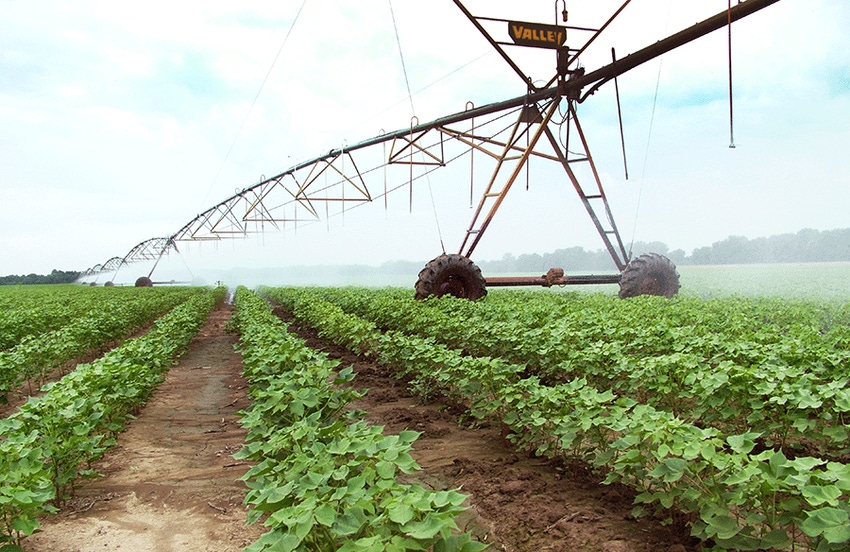
The next thing you may be using in your center-pivot irrigation systems may be a ‘plant tattoo.’
The new technology, developed by Iowa State University researchers and engineers, is showing great promise according to Patrick Schnable, who is heading the project.
“The tattoo is a monolayer of graphene oxide,” says the director of the Plant Sciences Institute at the university. “This particular compound that, when it interacts with water, the electrical conductivity changes.”
The very thin layer of graphene oxide is placed on the underside of a leaf. If an electrical current is run through it, the amount of moisture between the leaf and the tattoo is revealed.
“So, it’s a sensor for how much water the plant is losing through transpiration.”
Schnable and colleagues see several important applications for the technology.
“One possibility is being able to breed crops that are more water efficient. The second is this will be a great tool for controlling irrigation systems.
“Where there are a lot of center-pivots, you can imagine having these tattoos on a sampling of plants in a whole section of a field. Those would be talking wirelessly to a controller at the wellhead and that would tell the center-pivot exactly how much water to put out as it moves around the circumference of the field.”
How did the idea for the tattoos come up?
“I’m a plant biologist and about three years ago I was appointed to my current role. For years, I’ve wanted to engage engineers and show them the very exciting and high-impact challenges we face in agriculture.
“I wanted to get them engaged and have these very bright minds start thinking of solutions. I love working with engineers – show them a challenge and they’ll run with it.”
The invention was built by an electrical engineer who’d been building wearable sensors for humans. Schnable got the engineer interested in plants and crops.
“My role has really been to tell him how important the problem is and then doing testing to show it’s working the way we’d hoped.”
So far the tattoos have only been tested in the greenhouse. They will be carried into the field this summer.
How do the tattoos work?
“This is cool and where the ‘Band-Aid’ idea came from. The graphene oxide is on a piece of gas-permeable tape. You open the package, peel off the backing and stick the tape with the graphene on the back of the leaf.
“The current version has wires that hang down. The electrical current is sent through the wires and tattoos and measures the resistance. A box at the plant interprets the conductivity and gives you the moisture concentration.
“We want to make the tattoos wireless so they can talk to the box somewhere near the wellhead. The idea is the irrigation will begin when the plants get thirsty.”
Nitrate “needle”
Schnable has also been developing an instant-read nitrate sensor, which will be tested by Iowa farmers this summer.
“This is a probe you can stick right into the stalk of a plant and get the concentration of nitrate in the stalk. In Iowa, you can imagine that information being used to make decisions about side-dressing corn.
“If you’re under irrigation, you could use the nitrate probe along with the plant tattoo in combination to do fertigation. So, the center-pivot wouldn’t only be told how much water to apply but how much nitrogen to add in throughout the growing season.”
Currently, Schnable and developers have set up a company “to commercialize these things. We’re negotiating with the university for intellectual property rights.”
What crops are being looked at with the nitrate sensors and tattoos?
“For the nitrate sensors we’re looking for partners that can test on multiple crops. It should be widely applicable. Anything you can stick a needle into you should be able to work with.”
The moisture sensors “should be equally widely applicable. Next year, we’ll be looking for farmers to test on more crops. I think this could save farmers a huge amount of water in places like California. We want to test them in cotton, in soybeans, everything.”
Questions
Are the new sensors on center-pivot manufacturers’ radar screens yet?
“We’ve talked to one of them. We don’t want to get too far ahead and get people too excited before we’re fully ready to work with them. I think our big push to find such partners will happen (in 2019). The one we talked to was very interested, though.”
When informed about the new sensors, growers often ask about the systems’ durability.
“We’ll be testing durability out in the field this summer. They’ve done fine in the greenhouse. I’m not too worried about those things. Not to be dismissive of my colleagues, but I call with those kinds of questions ‘just engineering.’ By that, I mean if we find the water sensor peeling off the leaf, we’ll find different adhesives to use or something. There are ways to make it work.”
Another question: what happens if the leaf continues to grow?
“There are two answers to that. One is obviously to just put the tattoo on once the leaf is fully expanded. But we’re also looking at ways for the tattoo to actually expand as the leaf grows.”
About the Author(s)
You May Also Like




